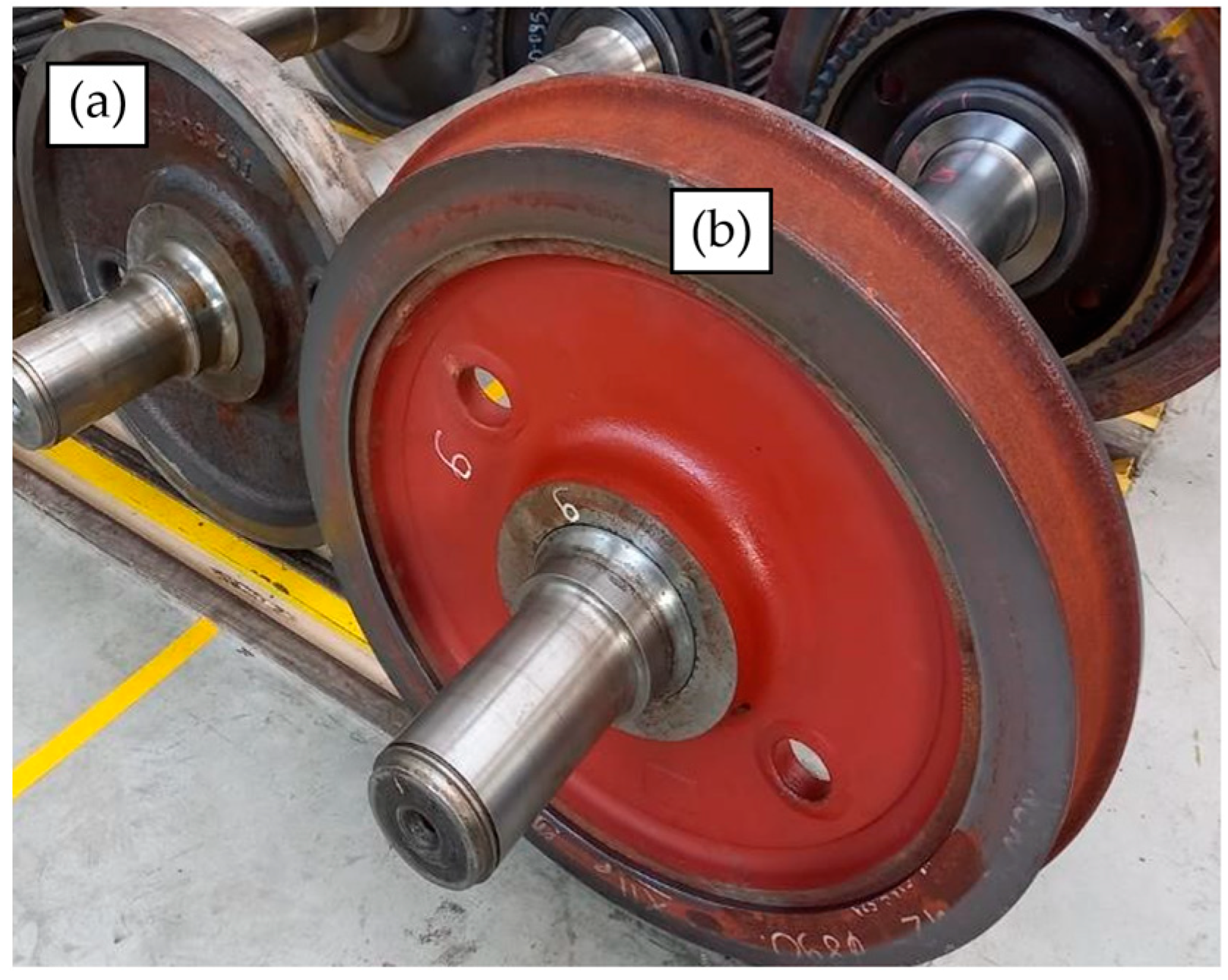Analysis of the Wear Mechanism and the Influence of the Chemical Composition and Repair Welds of the Pig Iron Wagon Wheels
Abstract
1. Introduction
- allowing the vehicle to move on the track;
- transferring the weight of the loaded vehicle;
- transferring the driving and braking forces, as well as dynamic loads caused by track unevenness.
- monoblock wheels;
1.1. Monoblock Wheel Construction
1.2. Operation of a Railway Wheel
- (a)
- rolling surface (6–17%);
- (b)
- outer edge (40–60%);
- (c)
- flange (2–10%);
- (d)
- marks on the outer side surface (3–10%);
- (e)
- marks on the inner side surface (2–5%);
- (f)
- defective attachment surface (10–35%).
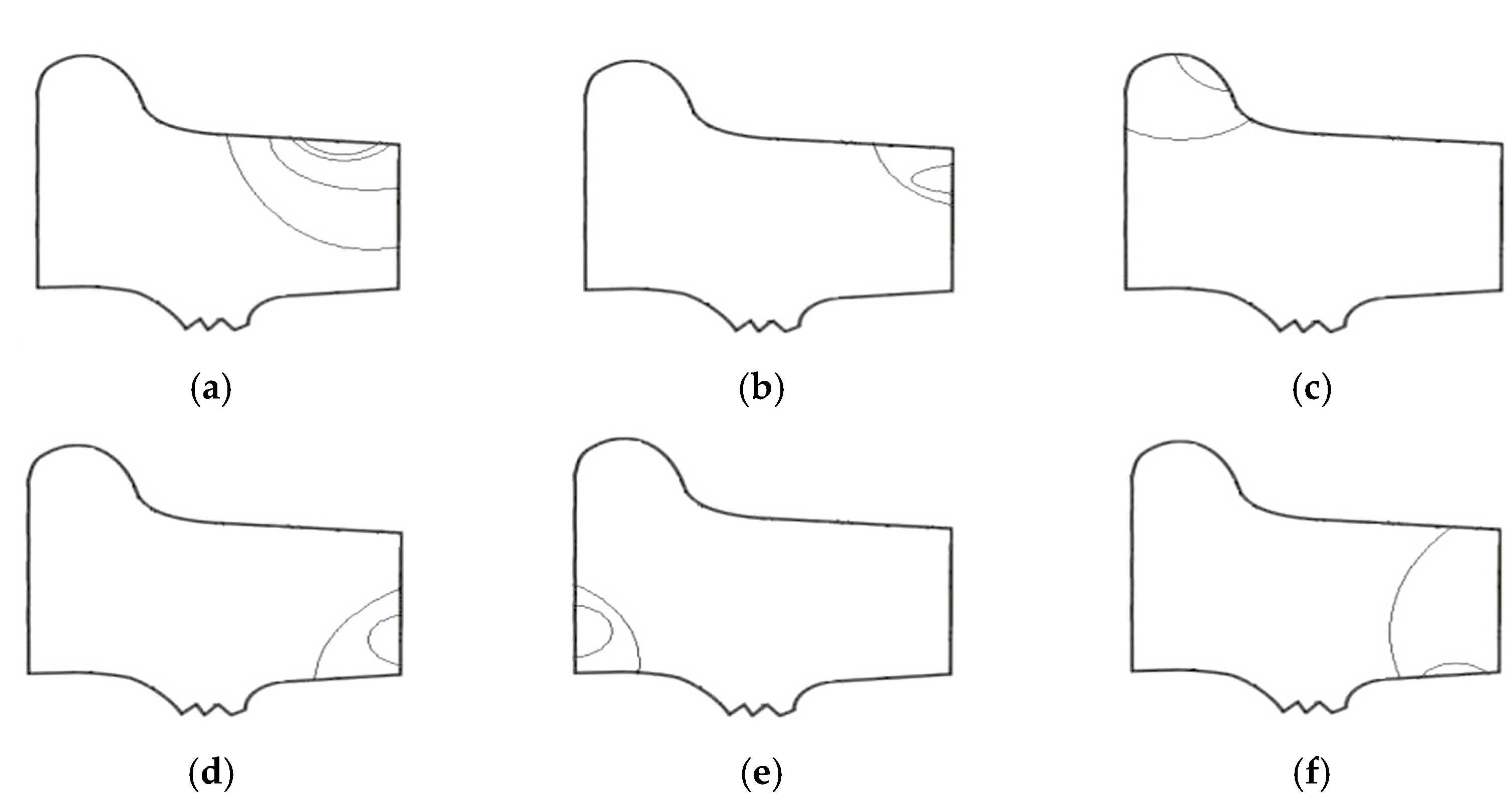
1.3. Welding Repair Method of Cast Wheels
1.4. Cast Steel Used for Monoblock Wheels
2. Materials and Methods
- macroscopic observations;
- microstructural analysis;
- chemical composition analysis;
- hardness measurements.

3. Results
3.1. Analysis of the Samples Taken from the Wheel Flange
3.1.1. Macroscopic Assessment of the Fraction of Areas Modified by Post Foundry Processing
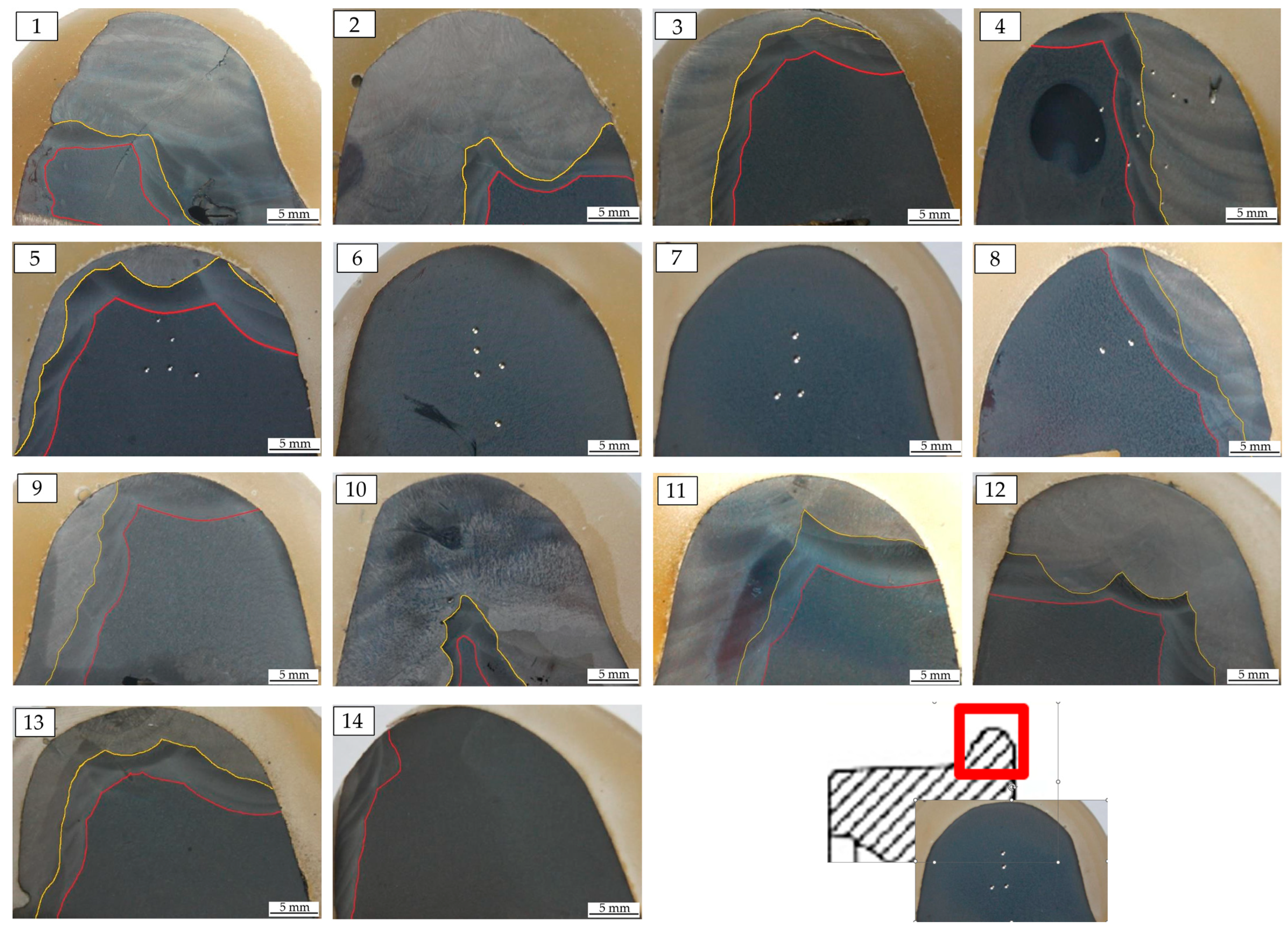
3.1.2. Chemical Composition Analysis
3.1.3. Microstructural Analysis
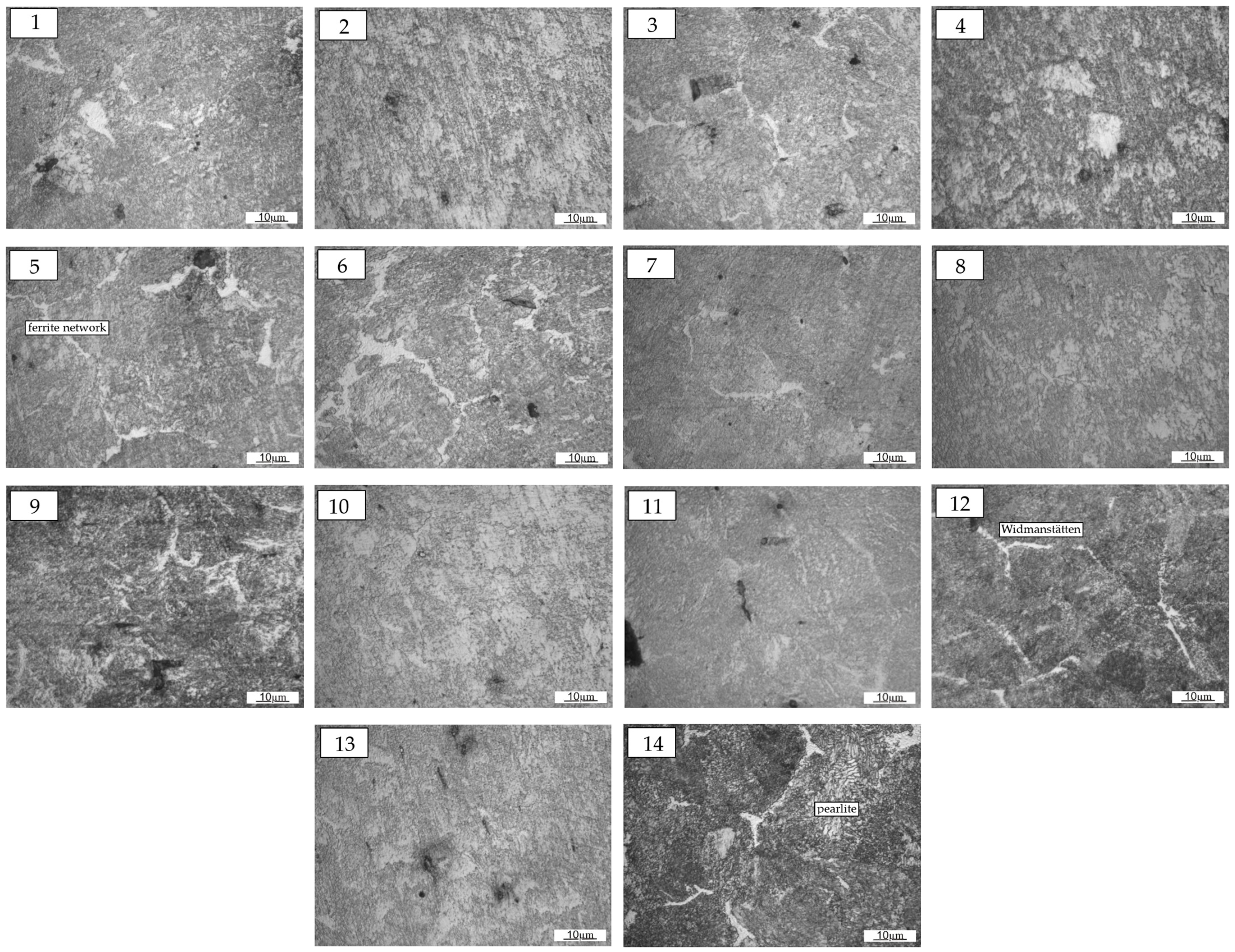
3.1.4. Quantitative Evaluation of Macro and Microstructural Characteristics
3.2. Analysis of Samples Collected from the Wheel Tread Edge Area
3.2.1. Macroscopic Evaluation of the Prevalence of Typical Welding Zones
3.2.2. Chemical Composition Test Results
3.2.3. Microstructural Analysis
3.2.4. Hardness Measurement
4. Discussion
4.1. Effect of Chemical Composition on Microstructure and Hardness
4.2. Influence of Microstructure on Hardness
4.3. Analysis of the Correctness of the Assumptions Regarding the Occurrence and Nature of the Weld, the Heat-Affected Zone, and the Parent Material
4.4. Influence of Chemical Composition on Weld Hardness
4.5. Relationship Between Chemical Composition and Deformation Degree
4.6. Influence of Deformation Degree on Hardness
5. Conclusions
- It was discovered that padding welds were conducted at two distinct stages: initially, during the repair of bare wheel castings, and subsequently, following the completion of post-operation repairs.
- The microstructure of the weld is predominantly bainitic.
- The primary mechanism of wear observed in bare wheel components, both in the vicinity of welds and in the parent material, is the plastic flow of the material. It resulted in a change in the geometry of the wheel tread edge area, making further operation of the wheel impossible. Plastic flow occurred towards the free surface, and the presence of regenerative welds in the area of the wheel working surface may indicate earlier wear of the wheels due to the fatigue mechanism. Cracking was initiated on the surface or just below the surface in the area of the maximum shear stress (Hertz), and these cracks most likely resulted in defects that were filled by surfacing.
- The hardness of the material is dependent upon the chemical composition, the microstructural components, and the degree of plastic deformation.
- The addition of alloying elements results in increased hardness;
- The formation of non-equilibrium structures (bainite) also results in increased hardness;
- The observed increase in hardness is a consequence of strain hardening due to exploitation.
- Increasing the alloyability as a result of the padding weld helps to achieve greater plasticity of the material.
- The proposed methodology for analyzing the research results enables the drawing of conclusions regarding the origin of the padding weld (repair of castings and regeneration after operation). It allows us to distinguish the results of repair processes of wear effects in a highly loaded friction node with unsteady lubrication conditions (environmental influence) from repair processes applied to castings of large construction components.
Author Contributions
Funding
Data Availability Statement
Acknowledgments
Conflicts of Interest
References
- Szudyga, M. Diagnostics of Fatigue by Magnetic Methods of Steel Used in Railway Wheels and Rims of Railway Wheel Sets. Ph.D. Thesis, Silesian University of Technology, Katowice, Poland, 2011. [Google Scholar]
- Zhou, H.; Zhang, H.; Yang, C. Hybrid-model-based intelligent optimization of ironmaking process. IEEE Trans. Ind. Electron. 2019, 67, 2469–2479. [Google Scholar] [CrossRef]
- Adilson de Castro, J.; Medeiros, G.A.d.; Oliveira, E.M.d.; de Campos, M.F.; Nogami, H. The Mini Blast Furnace Process: An Efficient Reactor for Green Pig Iron Production Using Charcoal and Hydrogen-Rich Gas: A Study of Cases. Metals 2020, 10, 1501. [Google Scholar] [CrossRef]
- Łędzki, A.; Zieliński, K.; Klimczyk, A. Basics of Manufacturing and Processing Technology. Part V. Steelmaking; AGH University of Kraków: Cracow, Poland, 2015. [Google Scholar]
- EN 13262:2020; Railway Application. Wheelsets and Bogies. Wheels. Product Requirements. European Standard: Brussels, Belgium, 2020.
- Available online: https://www.transportszynowy.pl/Kolej/zestawykolowe-kola (accessed on 30 November 2024).
- Zani, N.; Mazzù, A.; Solazzi, L.; Petrogalli, C. Examining Wear Mechanisms in Railway Wheel Steels: Experimental Insights and Predictive Mapping. Lubricants 2024, 12, 93. [Google Scholar] [CrossRef]
- Shi, Z.; Nencioni, L.; Meli, E.; Ding, H.; Wang, W.; Andrea, R. Effect of Material Hardness Ratio on Wear and Rolling Contact Fatigue: Development and Validation of New Laws. Wear 2023, 514–515, 204561. [Google Scholar] [CrossRef]
- Zhou, G.Y.; Liu, J.H.; Wang, W.J.; Wen, G.; Liu, Q.Y. Study on the fatigue and wear characteristics of four wheel materials. J. Mod. Transport. 2013, 21, 182–193. [Google Scholar] [CrossRef]
- Pointner, P. High strength rail steels—The importance of material properties in contact mechanics problems. Wear 2008, 265, 1373–1379. [Google Scholar] [CrossRef]
- Mendez, P.F.; Barnes, N.; Bell, K.; Borlea, S.D.; Gajapathi, S.S.; Guest, S.D.; Izadi, H.A.; Gol, K.; Wood, G. Welding processes for wear resistant overlays. J. Manuf. Process 2014, 16, 4–25. [Google Scholar] [CrossRef]
- SaifulAkmal, M.N.; Wahab, M.N. Characterization of UIC-54 Rail Head Surface Welded by Hardfacing Using Flux-Cored Steel Wire. In Recent Trends in Manufacturing and Materials Towards Industry 4.0; Lecture Notes in Mechanical Engineering; Osman Zahid, M.N., Abdul Sani, A.S., Mohamad Yasin, M.R., Ismail, Z., Che Lah, N.A., Mohd Turan, F., Eds.; Springer: Singapore, 2021. [Google Scholar] [CrossRef]
- Goo, B.-C.; Seo, J.-W.; Lee, Y.-J. Effect of Welding Polarity on Mechanical Properties of Submerged Arc Welded Railway Vehicle Wheels. Metals 2022, 12, 1381. [Google Scholar] [CrossRef]
- ISO 1005-1:1994; Railway Rolling Stock Material. Part 1: Rough-Rolled Tyres for Tractive and Trailing Stock—Technical Delivery Conditions. International Standard: Geneve, Switzerland, 1994.
- PN-K-88202:1996; Railway Rolling Stock-Steel Castings-Requirements and Tests. Polish Standard: Warsaw, Poland, 1996.
- Bogacz, R.; Świderski, Z. Simulation of exploitation conditions induced damage of rolling surface of rails and wheels. Symulacja w Badaniach i Rozwoju 2010, 1, 119–129. [Google Scholar]
- Vakkalagadda, M.; Vineesh, K. Causes and failure forms of railway Wheels. Mater. Today Proc. 2024, 98, 97–101. [Google Scholar] [CrossRef]
- Goo, B.C.; Hwang, S.; Choi, S.Y.; Lee, Y.J. Worn-Wheel Restoration by Welding and Evaluation of Mechanical Properties. J. Korean Soc. Railw. 2018, 21, 241–248. [Google Scholar] [CrossRef]
- Kim, B.-R.; Moon, K.Y.; Cho, J.S.; Lee, Y.J. Applicability Verification of Restoration by Welding to Extend the Lifetime of Railway Wheel. Acad. Soc. Appropr. Technol. 2023, 9, 81–88. [Google Scholar] [CrossRef]
- Maglio, M.; Vernersson, T.; Nielsen, J.C.O.; Ekberg, A.; Kabo, E. Influence of railway wheel tread damage on wheel–rail impact loads and the durability of wheelsets. Rail. Eng. Sci. 2024, 32, 20–35. [Google Scholar] [CrossRef]
- The Welding Institute (TWI). Remanufacture of Rail Wheels: Aurora Project. Available online: https://www.twi-global.com/media-and-events/insights/aurora-project-remanufacture-of-rail-wheels (accessed on 11 January 2024).
- Coo, B.C.; Lee, Y.J. Railway Vehicle Wheel Restoration by Submerged Arc Welding and Its Characterization. Sci 2020, 2, 33. [Google Scholar] [CrossRef]
- Gajvoronsky, A.A.; Poznyakov, V.D.; Sarzhevsky, V.A.; Vasiliev, V.G.; Orlovsky, V.Y. Influence of thermo-deformational cycle of hardfacing on the structure and properties of railway wheels at their reconditioning. Paton Weld. Sci. Tech. 2010, 5, 15–18. [Google Scholar] [CrossRef]
- Markisha, L.I.; Poznyakov, V.D.; Gajvoronsky, A.A.; Berdinkova, E.N.; Alekseenko, T.A. Structure and properties of railway wheel surface after restoration surfacing and service loading. Paton Weld. J. 2015, 5–6, 96–100. [Google Scholar] [CrossRef]
- Mičian, M.; Winczek, J.; Gucwa, M.; Koňár, R.; Málek, M.; Postawa, P. Investigation of Welds and Heat Affected Zones in Weld Surfacing Steel Plates Taking into Account the Bead Sequence. Materials 2020, 13, 5666. [Google Scholar] [CrossRef]
- Janiczak, R.; Pańcikiewicz, K. Laser welding of austenitic ferrofluid container for the KRAKsat satellite. Weld. World 2021, 65, 1347–1357. [Google Scholar] [CrossRef]
- Pańcikiewicz, K.; Radomski, W. Lack of tightness analysis of concealed welded radiators. Eng. Fail. Anal. 2020, 114, 104579. [Google Scholar] [CrossRef]
- Mi, G.-F.; Liu, Y.-L.; Zhang, B.; Fu, X.-Q.; Zhang, H.; Song, G.-X. Wear property of cast steel wheel material in rail truck. J. Iron Steel Res. Int. 2009, 16, 73–77. [Google Scholar] [CrossRef]
- Getmanova, M.E.; Ilyukhin, D.S.; Nikulin, A.N.; Filippov, G.A. Composition and properties of steel in cast and forged railroad wheels. Steel Transl. 2017, 47, 70–77. [Google Scholar] [CrossRef]
- PN-H-84027-1:1994; Railway Steel-Wheels-Types. Polish Standard: Warsaw, Poland, 1994.
- EN 10027-1:2016; Designation Systems for Steels-Part 1: Steel Names. European Standard: Brussels, Belgium, 2016.
- EN 10027-2:2015; Designation Systems for Steels-Part 2: Numerical System. European Standard: Brussels, Belgium, 2015.
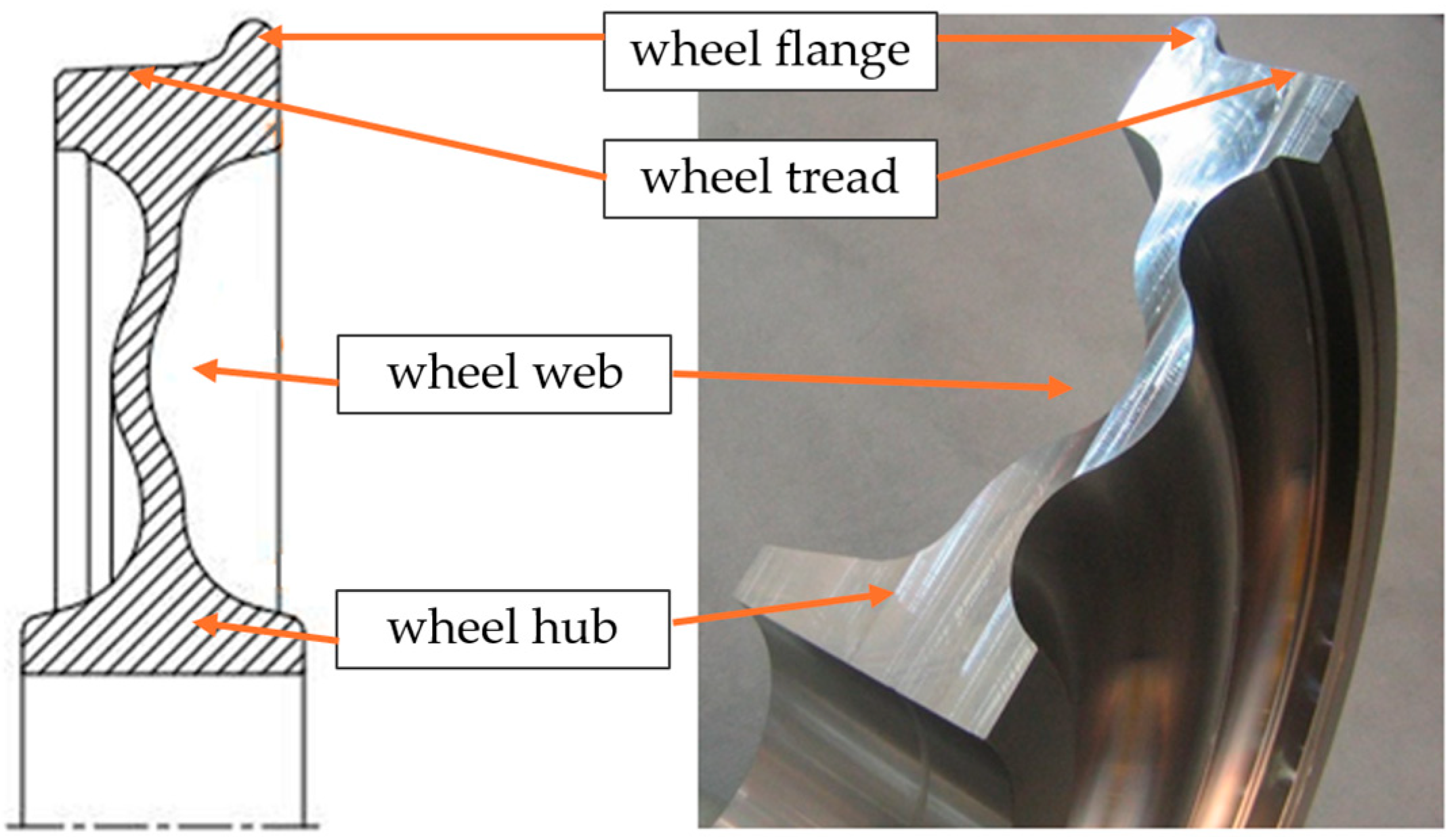
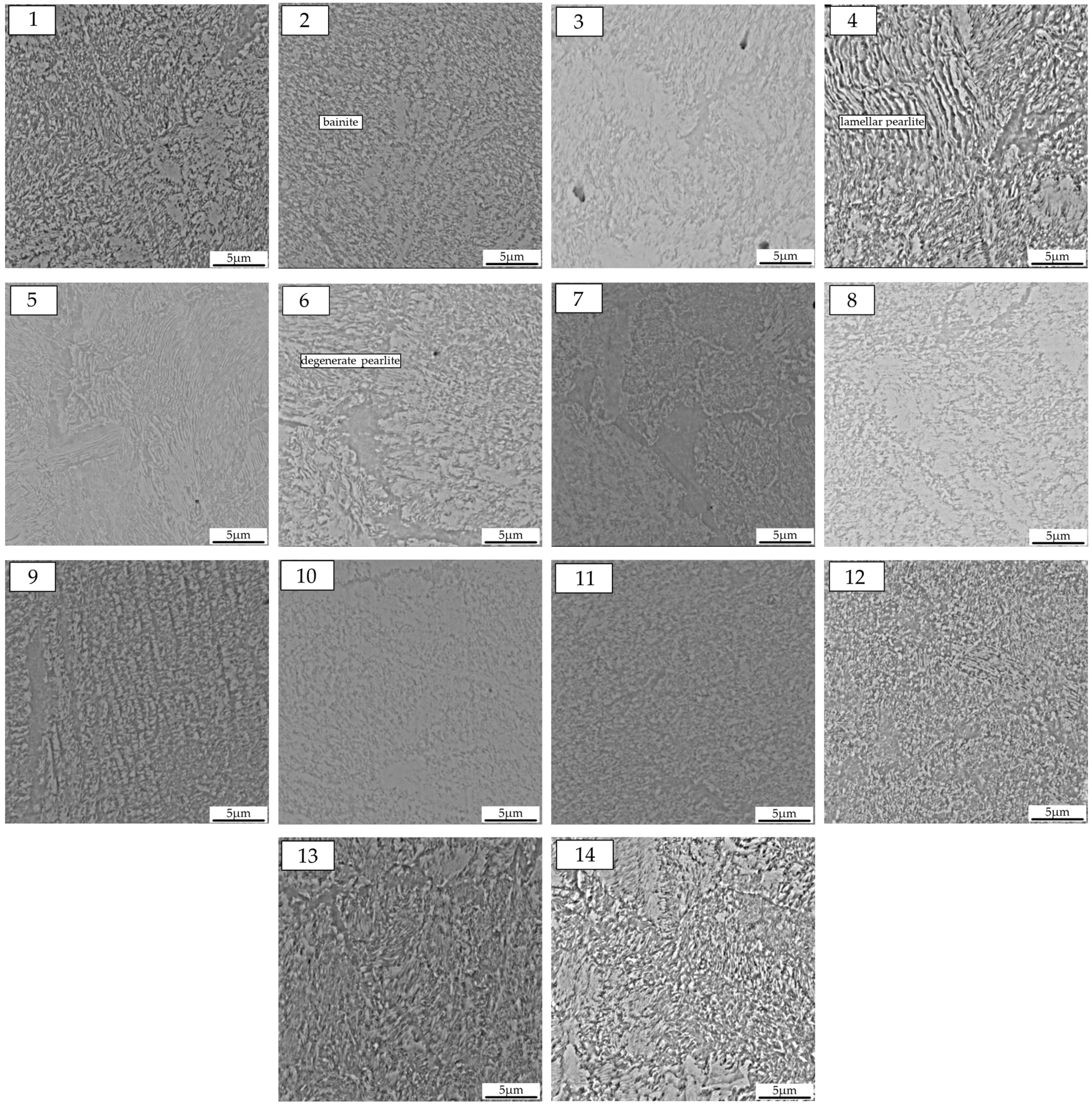
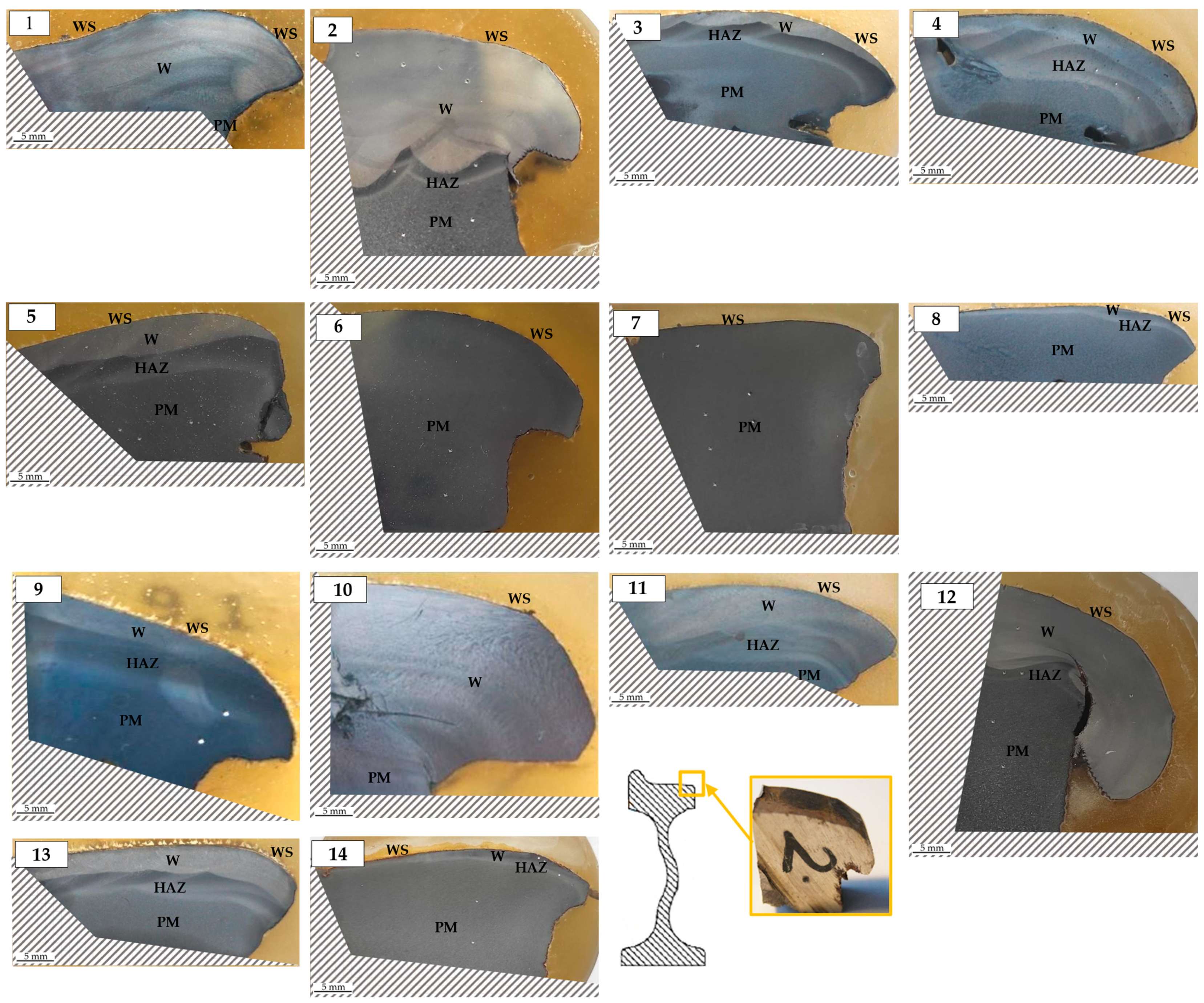
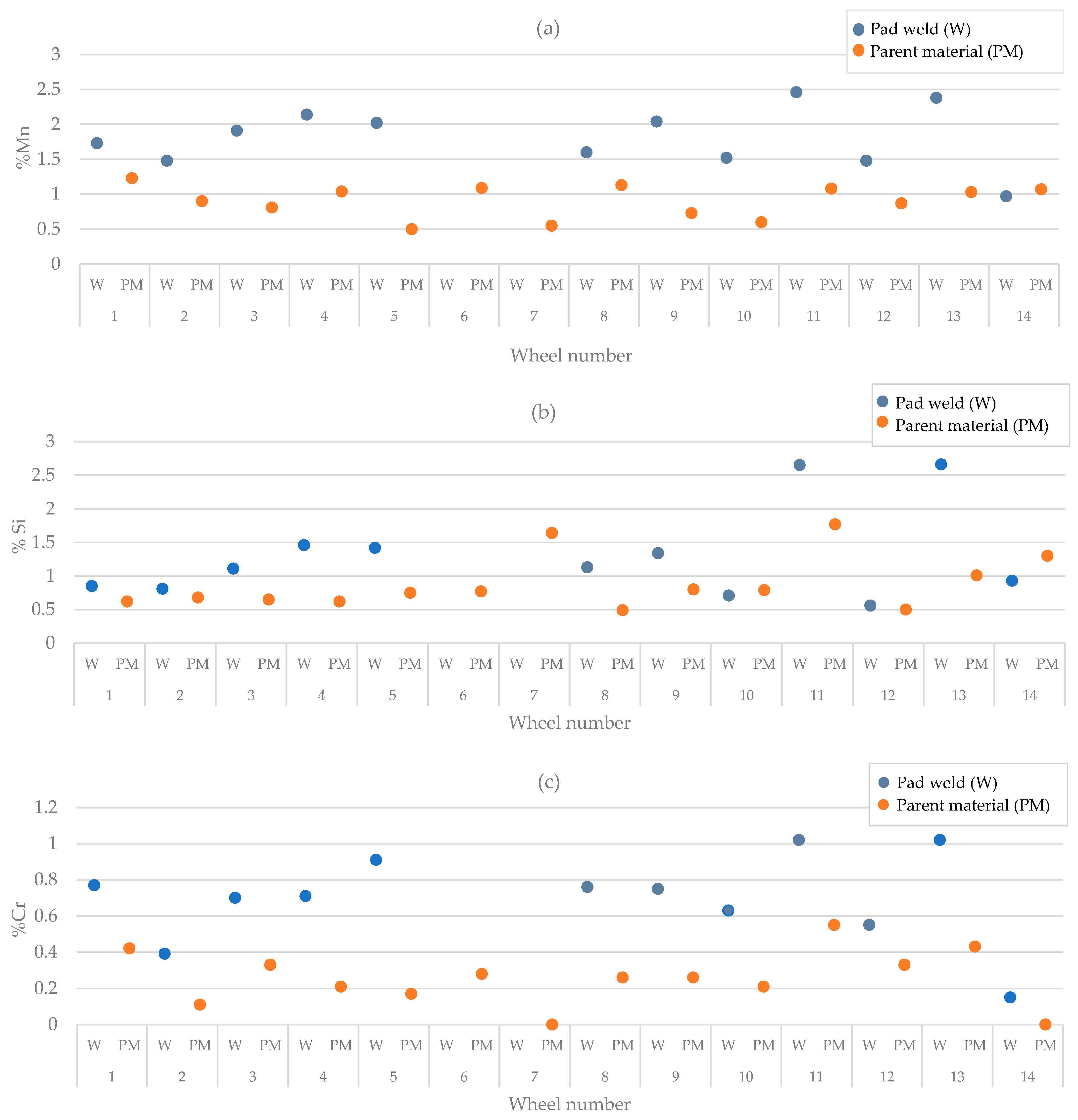

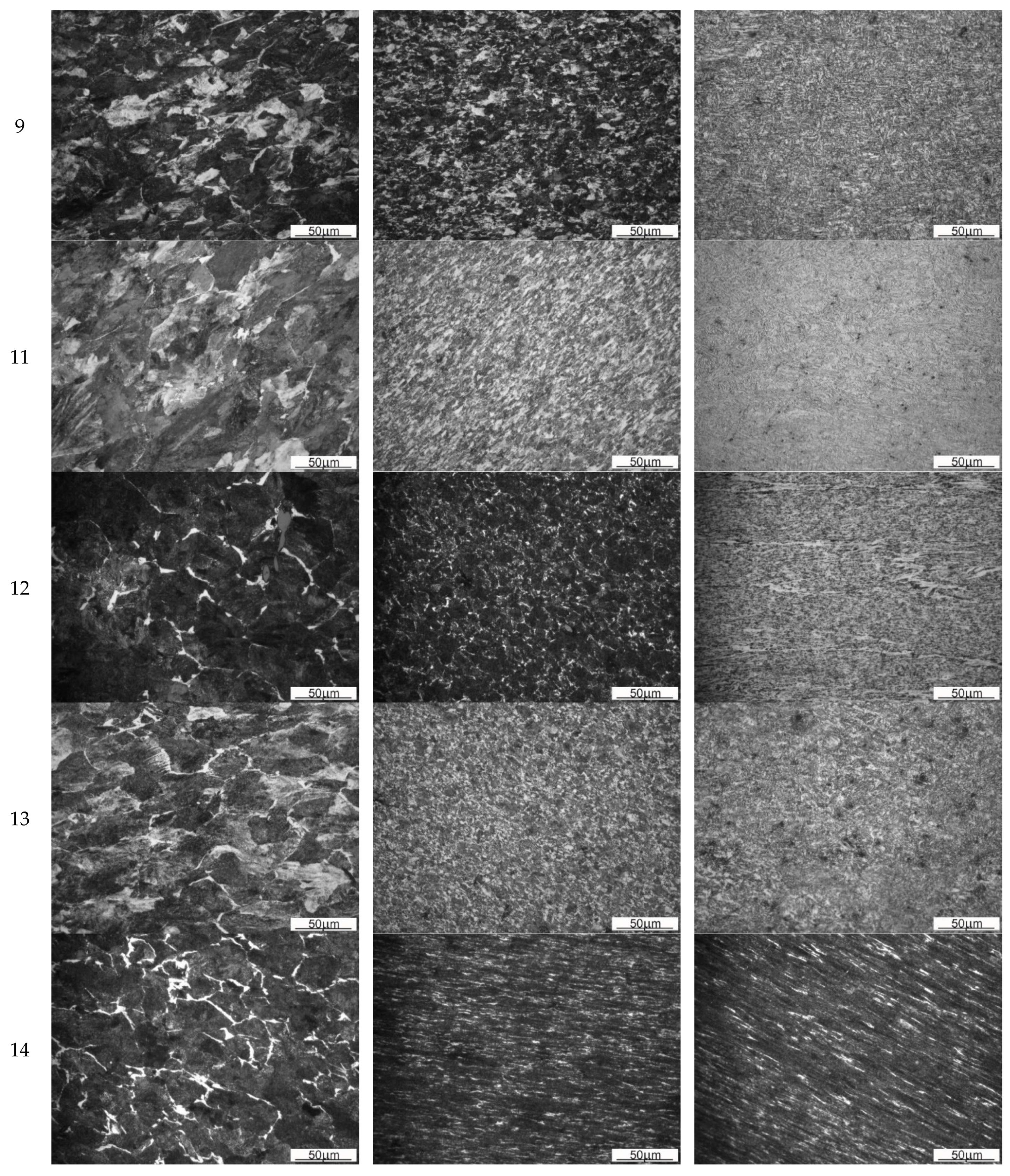
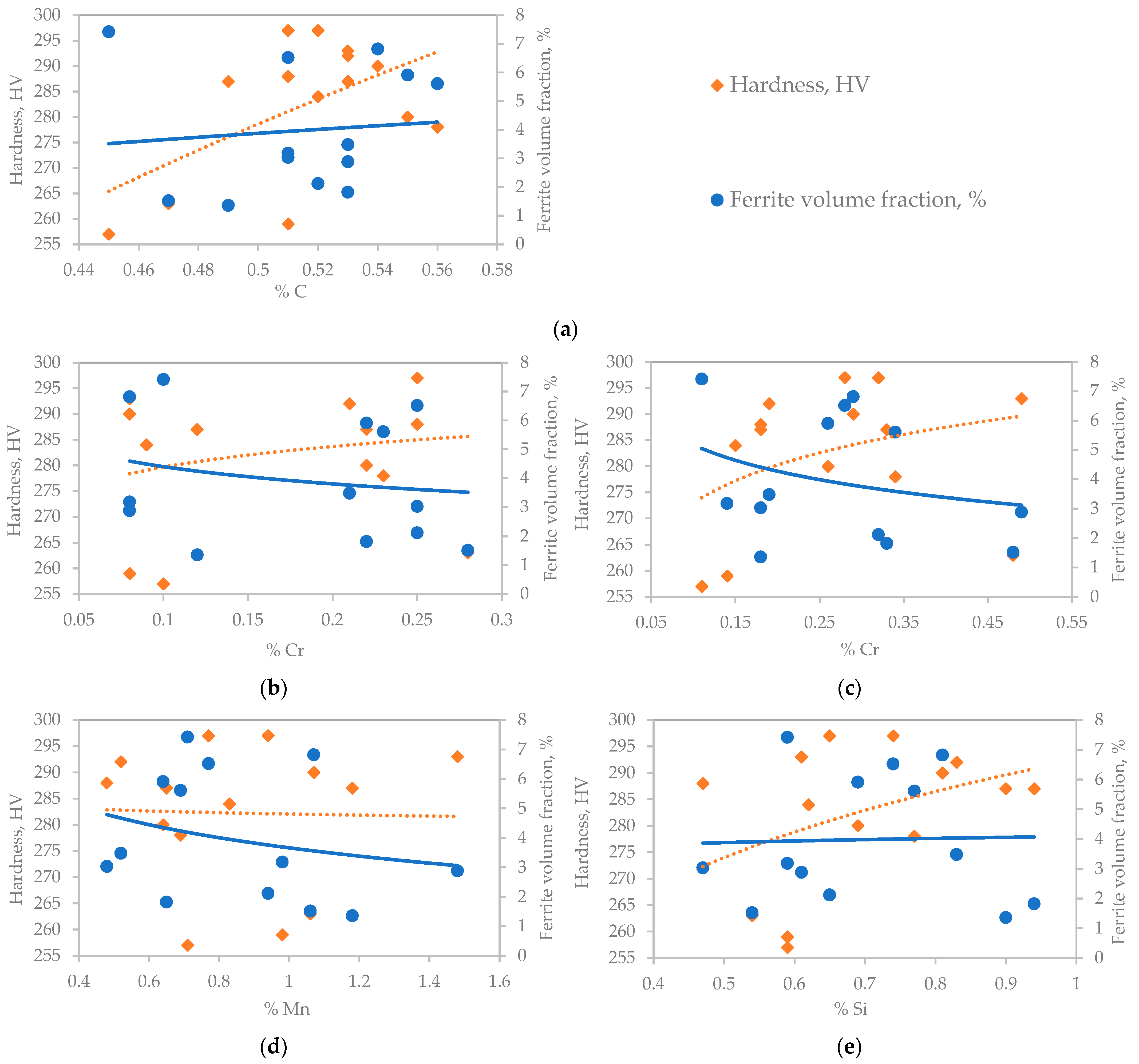


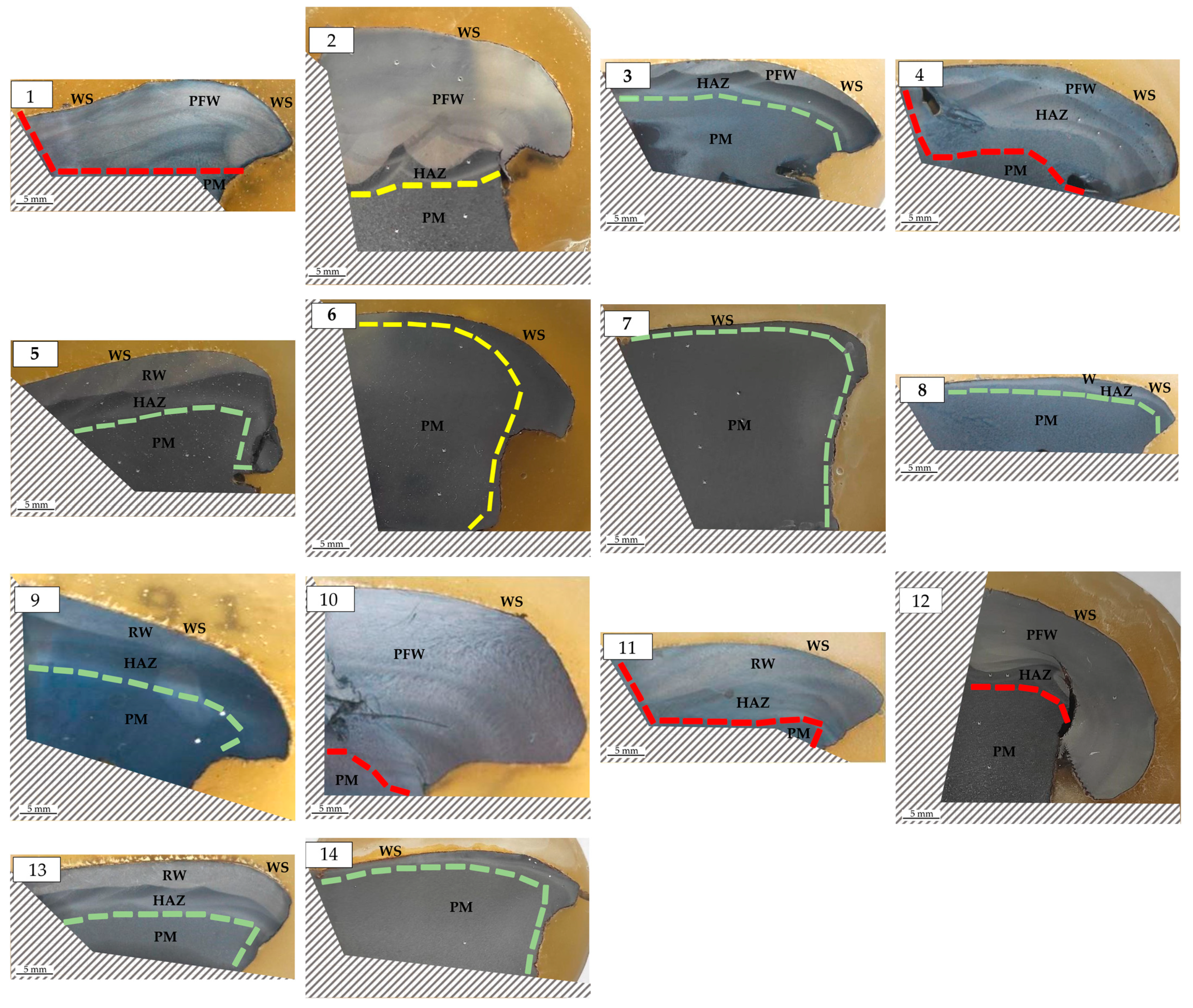


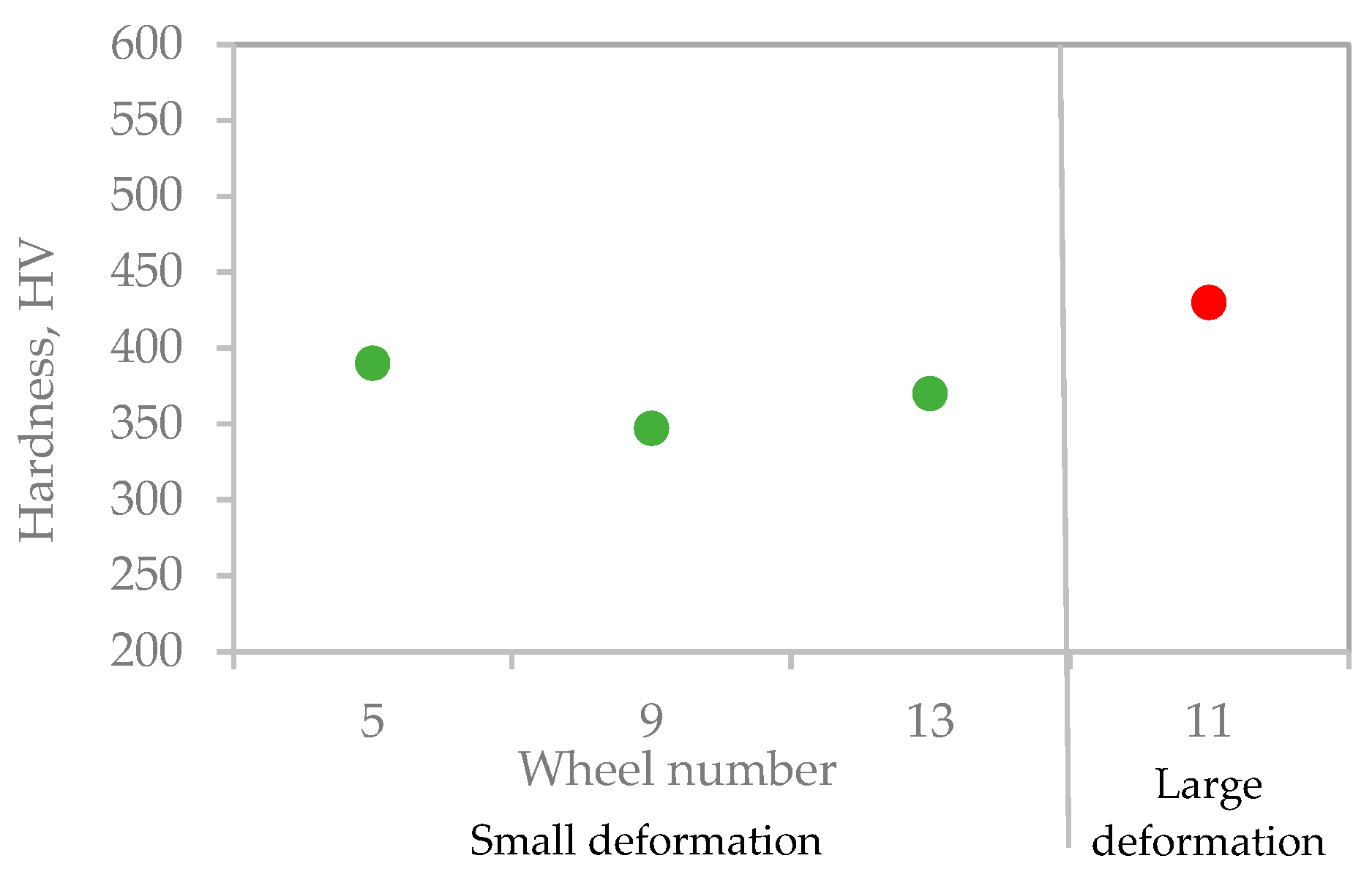
| Wheel Number | Chemical Composition (wt. %) | |||||||||||
|---|---|---|---|---|---|---|---|---|---|---|---|---|
| Fe | C | Si | Mn | P | S | Cr | Mo | Ni | Al | Co | Cu | |
| 1 | 98.0 | 0.56 | 0.47 | 0.44 | 0.008 | 0.015 | 0.23 | 0.006 | 0.16 | 0.003 | 0.006 | 0.08 |
| 2 | 97.9 | 0.49 | 0.31 | 0.89 | 0.015 | 0.018 | 0.12 | 0.005 | 0.06 | 0.002 | 0.005 | 0.15 |
| 3 | 98.0 | 0.55 | 0.45 | 0.44 | 0.010 | 0.016 | 0.22 | 0.005 | 0.14 | 0.003 | 0.004 | 0.08 |
| 4 | 98.2 | 0.52 | 0.33 | 0.65 | 0.010 | 0.014 | 0.09 | 0.005 | 0.05 | 0.001 | 0.003 | 0.10 |
| 5 | 98.1 | 0.53 | 0.46 | 0.43 | 0.007 | 0.015 | 0.21 | 0.007 | 0.14 | 0.003 | 0.004 | 0.08 |
| 6 | 98.2 | 0.45 | 0.40 | 0.64 | 0.013 | 0.016 | 0.10 | 0.005 | 0.05 | 0.003 | 0.003 | 0.10 |
| 7 | 98.3 | 0.51 | 0.31 | 0.57 | 0.008 | 0.014 | 0.08 | 0.005 | 0.05 | 0.002 | 0.003 | 0.10 |
| 8 | 98.2 | 0.53 | 0.33 | 0.65 | 0.007 | 0.011 | 0.08 | 0.005 | 0.04 | 0.003 | 0.003 | 0.11 |
| 9 | 97.7 | 0.51 | 0.43 | 0.57 | 0.007 | 0.010 | 0.25 | 0.039 | 0.35 | 0.003 | 0.005 | 0.07 |
| 10 | 98.0 | 0.53 | 0.47 | 0.44 | 0.009 | 0.019 | 0.22 | 0.009 | 0.13 | 0.006 | 0.004 | 0.08 |
| 11 | 97.8 | 0.51 | 0.36 | 0.54 | 0.006 | 0.011 | 0.25 | 0.041 | 0.34 | 0.002 | 0.005 | 0.07 |
| 12 | 97.8 | 0.52 | 0.36 | 0.55 | 0.007 | 0.011 | 0.25 | 0.039 | 0.35 | 0.001 | 0.005 | 0.07 |
| 13 | 97.8 | 0.47 | 0.30 | 0.60 | 0.011 | 0.018 | 0.28 | 0.005 | 0.26 | 0.001 | 0.006 | 0.14 |
| 14 | 98.1 | 0.54 | 0.36 | 0.66 | 0.011 | 0.015 | 0.08 | 0.005 | 0.04 | 0.003 | 0.003 | 0.10 |
| Wheel Number | Chemical Composition (wt. %) | |||
|---|---|---|---|---|
| Fe | Si | Mn | Cr | |
| 1 | 98.20 | 0.77 | 0.69 | 0.34 |
| 2 | 97.75 | 0.90 | 1.18 | 0.18 |
| 3 | 98.40 | 0.69 | 0.64 | 0.26 |
| 4 | 98.39 | 0.62 | 0.83 | 0.15 |
| 5 | 98.46 | 0.83 | 0.52 | 0.19 |
| 6 | 98.59 | 0.59 | 0.71 | 0.11 |
| 7 | 98.29 | 0.59 | 0.98 | 0.14 |
| 8 | 97.41 | 0.61 | 1.48 | 0.49 |
| 9 | 98.22 | 0.74 | 0.77 | 0.28 |
| 10 | 98.08 | 0.94 | 0.65 | 0.33 |
| 11 | 98.87 | 0.47 | 0.48 | 0.18 |
| 12 | 98.09 | 0.65 | 0.94 | 0.32 |
| 13 | 97.92 | 0.54 | 1.06 | 0.48 |
| 14 | 97.82 | 0.81 | 1.07 | 0.29 |
| Wheel Number | Hardness, HV30 | Post Foundry Modified Areas Volume Fraction, % | Mean Area of Primary Austenite Grains, µm2 | Ferrite Volume Fraction, % |
|---|---|---|---|---|
| 1 | 278 | 88 | 528 | 5.61 |
| 2 | 287 | 78 | 894 | 1.36 |
| 3 | 280 | 31 | 515 | 5.91 |
| 4 | 284 | 40 | 945 | - * |
| 5 | 292 | 12 | 465 | 3.48 |
| 6 | 257 | 0 | 481 | 7.42 |
| 7 | 259 | 0 | 645 | 3.18 |
| 8 | 293 | 19 | 805 | 2.88 |
| 9 | 297 | 17 | 594 | 6.52 |
| 10 | 287 | 92 | 746 | 1.82 |
| 11 | 288 | 48 | 847 | 3.03 |
| 12 | 297 | 67 | 1564 | 2.12 |
| 13 | 263 | 35 | 1478 | 1.52 |
| 14 | 290 | 0 | 1251 | 6.82 |
| Wheel Number | Mn (wt. %) | Si (wt. %) | Cr (wt. %) | |||
|---|---|---|---|---|---|---|
| Parent Material | Weld | Parent Material | Weld | Parent Material | Weld | |
| 1 | 1.23 | 1.73 | 0.62 | 0.85 | 0.42 | 0.77 |
| 2 | 0.90 | 1.48 | 0.68 | 0.81 | 0.11 | 0.39 |
| 3 | 0.81 | 1.91 | 0.65 | 1.11 | 0.33 | 0.70 |
| 4 | 1.04 | 2.14 | 0.62 | 1.46 | 0.21 | 0.71 |
| 5 | 0.50 | 2.02 | 0.75 | 1.42 | 0.17 | 0.91 |
| 6 | 1.09 | - | 0.77 | - | 0.28 | - |
| 7 | 1.14 | - | 0.81 | - | 0.30 | - |
| 8 | 1.13 | 1.60 | 0.49 | 1.13 | 0.26 | 0.76 |
| 9 | 0.73 | 2.04 | 0.80 | 1.34 | 0.26 | 0.75 |
| 10 | 0.60 | 1.52 | 0.79 | 0.71 | 0.21 | 0.63 |
| 11 | 1.08 | 2.46 | 1.77 | 2.65 | 0.55 | 1.02 |
| 12 | 0.87 | 1.48 | 0.50 | 0.56 | 0.33 | 0.55 |
| 13 | 1.03 | 2.38 | 1.01 | 2.66 | 0.43 | 1.02 |
| 14 | 1.07 | 0.97 | 1.30 | 0.93 | 0.00 | 0.15 |
| Wheel Number | Measurement Number | Weld | Heat-Affected Zone | Parent Material | |||
|---|---|---|---|---|---|---|---|
| Hardness | Mean Hardness | Hardness | Mean Hardness | Hardness | Mean Hardness | ||
| 1 | 1 | 310 | 310 | - | 263 | 270 | |
| 2 | 310 | 283 | |||||
| 2 | 1 | 344 | 370 | 395 | 400 | 329 | 310 |
| 2 | 396 | 407 | 284 | ||||
| 3 | 1 | 230 | 240 | 235 | 230 | 315 | 300 |
| 2 | 250 | 231 | 277 | ||||
| 4 | 1 | 377 | 380 | 328 | 360 | 332 | 320 |
| 2 | 390 | 400 | 300 | ||||
| 5 | 1 | 380 | 390 | 354 | 360 | 308 | 310 |
| 2 | 405 | 359 | 315 | ||||
| 6 | 1 | - | - | - | - | 298 | 270 |
| 2 | - | - | 251 | ||||
| 7 | 1 | - | - | - | - | 312 | 295 |
| 2 | - | - | 263 | ||||
| 8 | 1 | 300 | 332 | - | - | 342 | 320 |
| 2 | 295 | - | 299 | ||||
| 9 | 1 | 301 | 347 | 332 | 340 | 293 | 270 |
| 2 | 425 | 347 | 238 | ||||
| 10 | 1 | 297 | - | - | - | 312 | 395 |
| 2 | 289 | - | 277 | ||||
| 11 | 1 | 389 | 430 | 330 | 340 | 302 | 320 |
| 2 | 465 | 360 | 337 | ||||
| 12 | 1 | 305 | 310 | 300 | 310 | 270 | 260 |
| 2 | 306 | 318 | 254 | ||||
| 13 | 1 | 376 | 370 | 317 | 310 | 304 | 290 |
| 2 | 370 | 296 | 278 | ||||
| 14 | 1 | 265 | 280 | 280 | 300 | 274 | 280 |
| 2 | 298 | 311 | 280 | ||||
Disclaimer/Publisher’s Note: The statements, opinions and data contained in all publications are solely those of the individual author(s) and contributor(s) and not of MDPI and/or the editor(s). MDPI and/or the editor(s) disclaim responsibility for any injury to people or property resulting from any ideas, methods, instructions or products referred to in the content. |
© 2025 by the authors. Licensee MDPI, Basel, Switzerland. This article is an open access article distributed under the terms and conditions of the Creative Commons Attribution (CC BY) license (https://creativecommons.org/licenses/by/4.0/).
Share and Cite
Krawczyk, J.; Frocisz, Ł.; Matusiewicz, P. Analysis of the Wear Mechanism and the Influence of the Chemical Composition and Repair Welds of the Pig Iron Wagon Wheels. Lubricants 2025, 13, 79. https://doi.org/10.3390/lubricants13020079
Krawczyk J, Frocisz Ł, Matusiewicz P. Analysis of the Wear Mechanism and the Influence of the Chemical Composition and Repair Welds of the Pig Iron Wagon Wheels. Lubricants. 2025; 13(2):79. https://doi.org/10.3390/lubricants13020079
Chicago/Turabian StyleKrawczyk, Janusz, Łukasz Frocisz, and Piotr Matusiewicz. 2025. "Analysis of the Wear Mechanism and the Influence of the Chemical Composition and Repair Welds of the Pig Iron Wagon Wheels" Lubricants 13, no. 2: 79. https://doi.org/10.3390/lubricants13020079
APA StyleKrawczyk, J., Frocisz, Ł., & Matusiewicz, P. (2025). Analysis of the Wear Mechanism and the Influence of the Chemical Composition and Repair Welds of the Pig Iron Wagon Wheels. Lubricants, 13(2), 79. https://doi.org/10.3390/lubricants13020079




